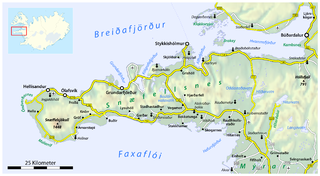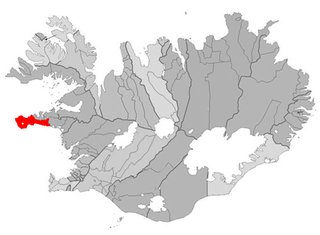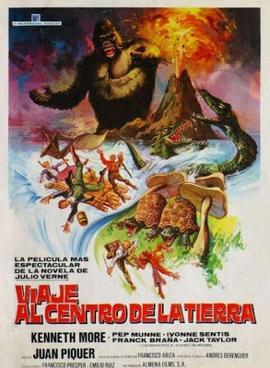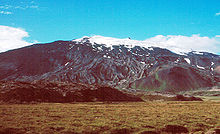
A subterranean river is a river or watercourse that runs wholly or partly beneath the ground, one where the riverbed does not represent the surface of the Earth. It is distinct from an aquifer, which may flow like a river but is contained within a permeable layer of rock or other unconsolidated materials. A river flowing below ground level in an open gorge is not classed as subterranean.

From the Earth to the Moon: A Direct Route in 97 Hours, 20 Minutes is an 1865 novel by Jules Verne. It tells the story of the Baltimore Gun Club, a post-American Civil War society of weapons enthusiasts, and their attempts to build an enormous Columbiad space gun and launch three people — the Gun Club's president, his Philadelphian armor-making rival, and a French poet — in a projectile with the goal of a Moon landing. Five years later, Verne wrote a sequel called Around the Moon.

Journey to the Center of the Earth is a 1959 American science fiction adventure film in color by De Luxe, distributed by 20th Century Fox. The film, produced by Charles Brackett and directed by Henry Levin, stars James Mason, Pat Boone, and Arlene Dahl. Bernard Herrmann wrote the film score, and the film's storyline was adapted by Charles Brackett from the 1864 novel of the same name by Jules Verne.

Snæfellsjökull is a 700,000-year-old glacier-capped stratovolcano in western Iceland. It is situated on the westernmost part of the Snæfellsnes peninsula. Sometimes it may be seen from the city of Reykjavík over Faxa Bay, at a distance of 120 km (75 mi).

The Snæfellsnes is a peninsula situated to the west of Borgarfjörður, in western Iceland.

The Mysterious Island is a novel by Jules Verne, published in 1875. The first edition, published by Hetzel, contains illustrations by Jules Férat. The novel is a crossover sequel to Verne's famous Twenty Thousand Leagues Under the Seas (1870) and In Search of the Castaways (1867–68), though its themes are vastly different from those books. An early draft of the novel, rejected by Verne's publisher and wholly reconceived before publication, was titled Shipwrecked Family: Marooned with Uncle Robinson, indicating the influence of the novels Robinson Crusoe and The Swiss Family Robinson. Verne developed a similar theme in his novel, Godfrey Morgan.

Subterranean fiction is a subgenre of adventure fiction, science fiction, or fantasy which focuses on fictional underground settings, sometimes at the center of the Earth or otherwise deep below the surface. The genre is based on, and has in turn influenced, the Hollow Earth theory. The earliest works in the genre were Enlightenment-era philosophical or allegorical works, in which the underground setting was often largely incidental. In the late 19th century, however, more pseudoscientific or proto-science-fictional motifs gained prevalence. Common themes have included a depiction of the underground world as more primitive than the surface, either culturally, technologically or biologically, or in some combination thereof. The former cases usually see the setting used as a venue for sword-and-sorcery fiction, while the latter often features cryptids or creatures extinct on the surface, such as dinosaurs or archaic humans. A less frequent theme has the underground world much more technologically advanced than the surface one, typically either as the refugium of a lost civilization, or as a secret base for space aliens.

Journey to the Centre of the Earth is the second album by English keyboardist Rick Wakeman, released on 3 May 1974 by A&M Records. It is a live recording of the second of his two concerts at the Royal Festival Hall on 18 January 1974, the premiere of his 40-minute orchestral rock piece based on Jules Verne's 1864 science fiction novel of the same name. It tells the story of Professor Lidinbrook, his nephew Axel, and their guide Hans, who follow a passage to the Earth's centre originally discovered by Arne Saknussemm, an Icelandic alchemist. Wakeman performs with the London Symphony Orchestra, the English Chamber Choir, and a group of hand-picked musicians for his rock band, which later became the English Rock Ensemble. Actor David Hemmings narrates the story.

The Land That Time Forgot is a fantasy novel by American writer Edgar Rice Burroughs, the first of his Caspak trilogy. His working title for the story was "The Lost U-Boat". The sequence was first published in Blue Book Magazine as a three-part serial in the issues for August, October, and December 1918. The complete trilogy was later combined for publication in book form under the title of the first part by A. C. McClurg in June 1924. Beginning with the Ace Books editions of the 1960s, the three segments have usually been issued as separate short novels.

At the Earth's Core is a 1914 fantasy novel by American writer Edgar Rice Burroughs, the first in his series about the fictional "hollow earth" land of Pellucidar. It first appeared as a four-part serial in All-Story Weekly from April 4 to 25, 1914. It was first published in book form in hardcover by A. C. McClurg in July, 1922.
Journey to the Center of the Earth is an 1864 science fiction novel by Jules Verne.

Hellissandur is a village and part of the Snæfellsbær municipality at the northwestern tip of Snæfellsnes peninsula in western Iceland.

Journey to the Center of the Earth is a 2008 American 3D science fantasy action-adventure film directed by Eric Brevig and starring Brendan Fraser in the main role, Josh Hutcherson, Anita Briem, and Seth Meyers. Produced by New Line Cinema, it is an adaptation of Jules Verne's 1864 novel, and was released in 3D theaters by Warner Bros. Pictures on July 11, 2008.

Alien from L.A. is a 1988 science fiction film directed by Albert Pyun and starring Kathy Ireland as a young woman who visits the underground civilization of Atlantis. The film was featured on Mystery Science Theater 3000. This film is loosely based on Jules Verne's 1864 novel Journey to the Center of the Earth with some minor allusions to The Wizard of Oz.

Journey to the Center of the Earth is a 1989 fantasy film. It was a nominal sequel to the 1988 film Alien from L.A., both of which are (very) loosely based on the 1864 novel Journey to the Center of the Earth by Jules Verne.

Journey to the Center of the Earth is a 2008 direct-to-DVD film created by The Asylum and directed by David Jones and Scott Wheeler.

Viaje al centro de la Tierra is a 1977 Spanish adventure film based on the 1864 novel Journey to the Center of the Earth by Jules Verne. It has been released under the titles Where Time Began in theaters in the U.S. and The Fabulous Journey to the Centre of the Earth on TV in the U.K. It was a rare later leading role for Kenneth More.

Willy Fog 2 is a Spanish animated television adaptation of the novels Journey to the Center of the Earth and Twenty Thousand Leagues Under the Sea by Jules Verne, with the characters from Around the World with Willy Fog, produced by Spanish studio BRB Internacional and Televisión Española that was first broadcast on La 2 between 24 September 1994 and January 1995.
Jules Verne's 1870 novel Twenty Thousand Leagues Under the Sea has been adapted and referenced in popular culture on numerous occasions.

Journey to the Center of the Earth is a 1993 TV film first aired on NBC. It stars Carel Struycken, Tim Russ, and Jeffrey Nordling, John Neville, F. Murray Abraham, Fabiana Udenio, and Kim Miyori. A TV series was originally planned after its release but it was cancelled.




















